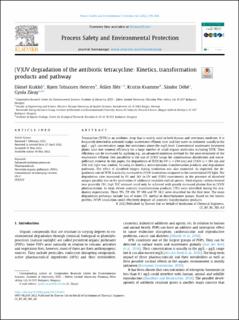| dc.description.abstract | Tetracycline (TETR) is an antibiotic drug that is widely used in both human and veterinary medicine. It is frequently detected in activated sludge, wastewater effluent, river and lake water or sediment, usually in the pg/L – µg/L concentration range, but sometimes above the mg/L level. Conventional wastewater treatment plants have low removal efficiency for a large number of small organic molecules including TETR. Their efficiency can be increased by applying e.g., an advanced oxidation method for the post-treatment of the wastewater effluent. One possibility is the use of (V)UV lamps for simultaneous disinfection and micropollutant removal. In this paper, the degradation of TETR by UV (λ = 254 nm) and (V)UV (λ = 185 nm and 254 nm) light was studied, focusing on kinetics, mineralization, transformation products and degradation pathways. The effect of dissolved oxygen during irradiation was also examined. As expected, the degradation rate of TETR drastically increased in (V)UV irradiation compared to the conventional UV light. The degradation rates increased by 9% and 16% in UV and (V)UV experiments in the presence of dissolved oxygen possibly due to the generation of additional oxidative radical species. Total organic carbon removal was generally 15%, high TOC removal could only be achieved with greatly increased photon flux in (V)UV photooxidation. In total, eleven aromatic transformation products (TPs) were identified during the irradiation experiments. Three TPs (TP 418, TP 398 and TP 383) were described for the first time. The main degradation pathways include loss of water, CO, methyl or dimethylamine groups. Based on the kinetic profiles, (V)UV irradiation could effectively degrade all aromatic transformation products. | en_US |

